
 The announcement that Verizon, the telecommunications giant, will partner with Healthsense, a home health monitoring company, indicates that the adoption of telehealth services beyond project pilots and government-funds required to bolster the market is real.
The announcement that Verizon, the telecommunications giant, will partner with Healthsense, a home health monitoring company, indicates that the adoption of telehealth services beyond project pilots and government-funds required to bolster the market is real.
Verizon is upgrading the FiOS network, which it will extend to senior housing and assisted living communities that would use Healthsense’s suite of remote health monitoring, personal emergency response systems, wireless nurse call, and wellness monitoring products. The broadband FiOS network is upgradeable to 100 megabits per second, which would enable the bandwidth required by home health technologies that require high performance and reliable network connectivity.
These services can be available community-wide, or on a resident-by-resident individual basis.
Health Populi’s Hot Points: Seniors tend to utilize more health services than younger people: the average person over 65 is managing at least three chronic conditions and takes at least 3 prescription medicines. This substantial burden of chronic disease can be better managed at home to prevent avoidable ER admissions, inpatient admissions, and visits to physicians’ offices — saving the individual patient time and travel cost, and conserving health care providers’ time and space that can be better used by sicker patients.
There have been several formidable barriers to the mainstream adoption of home telehealth, one aspect of what West Wireless terms “infrastructure-independent” health care. One has been regulatory: both the Federal Communications Commission and the Food and Drug Administration are working on more quickly introducing wireless medical devices to the market while ensuring patient safety and interoperability. The FCC will issue a final rule (proposed in 2010) expanding its radio spectrum service to include wireless test beds. The FDA’s Medical Device Innovation Initiative will compress the pre-market approval process to 150 days, which is roughly half the normal time lapse to approve new technologies.
A second major obstacle to telehealth deployment has been reimbursement: how would health care providers be compensated for linking up with, and supporting, patients’ care at home? A key new rule from the Centers for Medicare and Medicaid Services was announced on May 2, 2011, effective July 2011, which supports telemedicine by streamlining credentialing and privileging of telehealth providers delivering services to Medicare hospitals. This lowers the administrative burden of delivering telehealth and telemedicine services for hospitals and providers. This signals and CMS is embracing the value and potential for telehealth to extend services beyond the walls of institutions.
Post-script: @faisal_q, Faisal Qureshi my colleague on Twitter, asked me for a few more bullets on barriers. He noted the cost of FiOS which could be out-of-reach for some seniors. Other obstacles through the consumer-lens include:
Provider-connectivity: Who will be actually monitoring the patient from a distance? Does the patient’s monitoring device link to their medical home or personal physician? An on-call nurse or on-site clinical professional who is underpinned with an electronic health record?
Consumer acceptance: Will the target market of seniors want to live with remote health devices?
Value proposition and pricing: An historic barrier is cost. How will the Healthsense products bundled with FiOS be priced? How will the value be communicated and positioned to seniors — and their care-giving adult children?
Clearly, remote health monitoring, whether for seniors or “youngers” will require a team-oriented, integrative health approach. While the Verizon/Healthsense program is a positive sign for remote health monitoring, more barriers prevent significant short-term adoption. For more on the complex topic of Connected Health, see my white paper sponsored by the California HealthCare Foundation, The Connected Patient.




 Thank you FeedSpot for
Thank you FeedSpot for